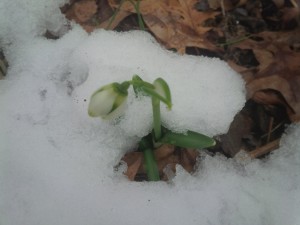
Yesterday I was absolutely beside myself because I saw the first snowdrops of the season. These brave early-appearers are double-flowered, with pale green tips on the outer petals and pronounced green blotches on the inner ones. I have forgotten their varietal name and the plant tag is currently submerged under a cover of dead leaves, but I know that I ordered the plants from Hitch Lyman at the Temple Nursery in the vast metropolis of Trumansburg, New York. Whatever the varietal name, they should be called “Trumpet” or “Hope of Spring” or even “Spring is Afoot”.
The winter weather has been on-and-off this year, so I have been expecting snowdrops since about January 15. Usually my first specimens are the common single-flowered type, Galanthus nivalis. This year, their tips have broken through the earth, but they are far from ready to display their charms to the public. The flashier doubles have much more heavy lifting to do because of their increased petal count, but they have beaten the nivalis snowdrops to the punch. I suspect that the doubles get a bit more warmth in their quiet corner of the lower back garden.
Snowdrops may be small, but their reputation grows every day. They have long had distinguished admirers, among them the suave and accomplished Edward Augustus Bowles, Victorian/Edwardian gardener, garden writer and artist par excellence. A great uncle by marriage to the current Duchess of Cornwall, Bowles was a rich man with a fantastic garden. His book My Garden in Autumn and Winter is still a classic among lovers of great garden literature. In its pages, Bowles makes snowdrop lovers drool with envy by describing the first snowdrops’ appearance in October, the continued show by various species in November and December, and the triumphant appearance of Galanthus nivalis later on. For Bowles, the nivalis snowdrops “come with a rush in February for Candlemas Day”, which happens on February second. For this reason, some traditional English gardeners called the little flowers, “Candlemas bells.” In the United States, we just don’t have the same poetry in our souls, but this may also have saved snowdrops from being christened “Groundhog’s Day bells”.
Across the pond from Bowles and separated by a generation, twentieth century southern gardener Elizabeth Lawrence also wrote about snowdrops. In her lovely book, The Little Bulbs, A Tale of Two Gardens, she writes with the enthusiasm of a true galanthophile, saying, “I, of course, would like to grow every snowdrop I ever heard of.” She speaks wistfully of a friend and snowdrop collector who manages to have five months of snowdrop bloom—something she cannot do in her North Carolina garden. Lawrence also quotes eighteenth century poet Anna Barbauld, who wrote perhaps the loveliest description of snowdrops, calling them, “the first pale blossoms of the unripened year.”
Armed with all that inspiration, you are probably dying to grow snowdrops. Depending on the species and variety, they can be completely unfussy, or terribly temperamental. My advice is to start with Galanthus nivalis, the most common type and, in my experience, the least diva-ish. If you know someone who already has snowdrops in his or her garden, ask for a small clump “in the green”–lifted right after the flowers fade. Dividing and planting clumps in the early spring is the best way to establish them. You can also order fall-planted bulbs from the same vendors who sell daffodils and tulips. Those bulbs may succeed as well, but can take a year or two to bloom.
Snowdrops can thrive in a variety of soils, but prefer shady woodland situations. They are partial to leaf mold, but dislike mulch. After the flowers fade, the foliage lingers for a bit until disappearing completely for the summer. Make sure to make the spots where you have planted the clumps or bulbs so you don’t disturb their slumbers.
Sometimes you can obtain ‘S. Arnott’, a larger and showier single snowdrop that smells even sweeter than its nivalis cousins. In my garden ‘S. Arnott’ increases almost as efficiently as the common snowdrops and is visible from farther away.
If the winter weather has abated where you live—even temporarily—go in search of snowdrops. Even if the groundhog has called for a few more weeks of winter, the little white bells will give you hope.
